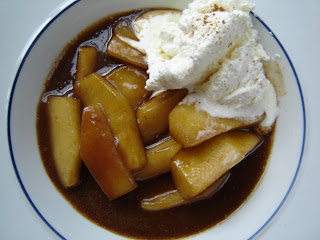
How does it go? Feed a cold, starve a fever?
Like many of you out there, I have a cold. I woke up on Tuesday morning feeling out of sorts, a bit anxious for no reason, and very tired. I drove home from work that night with a raging sore throat and a headache. To my embarrassment, I was also a little weepy and feeling very sorry for myself. I wanted my mom, who lives two thousand miles away, to put her hand to my forehead and murmur, "You're a little warmish," then make me some soup.
My befuddled mind decided to attempt a spicy chickpea soup. I found that the soup's main virtue is that it can be made almost entirely from the canned contents of your pantry, so it could be one of those "in a pinch" meals upon which we all rely from time to time. That said, my first, diseased attempt at this recipe wasn't great.
So we'll skip it (and who wants a soup that was made by someone with a nasty head cold anyway?). Instead, I have another Southern recipe for you, something that I made before getting sick. So it's okay to try, don't be concerned.
Shrimp Burgers.
Now, I was a tad put off by the title. Burgers, for me, should be beef (and not tofu or
tofurkey, or anything else that masquerades as something it is not). If it's not beef, it should be described as a sandwich. This may be a narrow-minded perspective, but I'm standing by it.
Steve really was fired up about the recipe, though, so I decided to give it a whirl. After all, I like shrimp and I like burgers. Stands to reason that I might like shrimp burgers, especially when they contain lemon zest and ginger.

Oh my, are these good eating. These are early-fall, bonfire on the beach in rolled up khakis good eating. They are bottled beer and a frisbee good eating. They are delicate little morsels of shrimp sweet with fresh corn and tangy with pepper vinegar and high-quality mayonnaise. Try 'em.
Shrimp BurgersAdapted from the Lee Bros. Cookbook1 pound of deveined, shelled shrimp
4 bay leaves
1 teaspoon pepper corns
1/4 cup of salt
1 teaspoon cayenne pepper
1 tablespoon scallions, chopped
1/8 cup fresh corn kernels, sliced directly from the cob (canned and frozen will not work here)
1 tablespoon fresh flat-leaf parsley, chopped
1/2 teaspoon freshly grated ginger
1 teaspoon grated lemon zest
1 tablespoon mayonnaise
3/4 cup unseasoned bread crumbs
Salt and pepper to taste
Pepper vinegar to taste (recipe follows)
1 egg, beaten
1 1/2 tablespoons canola oil
In a large saucepan, bring a quart of water to a boil, along with the bay leaves, pepper corns, 1/4 cup of salt, and cayenne pepper. Once the water comes to a boil, turn off the heat, add the shrimp, and cover. When the shrimp turn pink, within about 2 minutes, drain and run under cold water to stop the cooking. Coarsely chop the shrimp into small pieces.
In a large bowl, gently mix the shrimp with the scallions, corn, parsley, ginger, and lemon zest. Stir in the mayonnaise and bread crumbs, then add salt, pepper, and pepper vinegar to taste. Fold in the egg until it is evenly distributed. If the mixture seems too loose and wet, add bread crumbs in 1 tablespoon amounts until the shrimp mixture just holds its shape.
Form the shrimp mixture into 2 patties. Wrap the patties in plastic wrap and refrigerate for 30 minutes.
After 30 minutes, remove the patties from the refrigerator and unwrap. Heat the canola oil in a large, heavy-bottomed skillet over medium-high heat until the oil shimmers, then add the patties and saute on both sides until golden-brown.
Serve on a toasted roll with tartar sauce or a squeeze of lemon.
Serves: 2Pepper VinegarFrom the Lee Bros. Cookbook1 cup of white wine vinegar
1 fresh Serrano chile, cut in half lengthwise
Combine the ingredients in a resealable container and swish around. Refrigerate for 24 hours, then use as your little heat-seeking heart desires. Keep the container refrigerated.
Makes: 1 cup





































